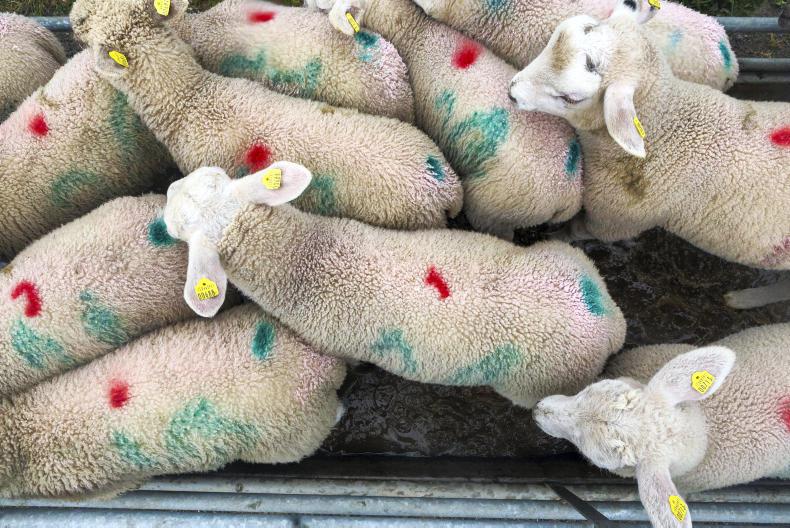Bord Bia is set to begin carbon footprinting quality assured (QA) Irish sheep farms for the first time.
The lamb carbon footprint, accredited by the Carbon Trust, will be calculated using data provided by farmers through a survey they will be requested to complete prior to their Bord Bia QA audit.
The survey will be piloted on a small number of farms in the coming weeks, before it becomes a requirement for all sheep farmers later this year. Bord Bia already calculates the carbon footprint of beef and dairy farms.
The carbon footprint will be calculated based on CO2-equivalent per kilogram of live weight lamb.
Data
Deirdre Ryan, director of Origin Green and sustainable assurance at Bord Bia, said: “Our unique national infrastructure, through the sustainable assurance schemes, allows Bord Bia to access and quantify the environmental performance of Irish beef and dairy farms at scale.
“We can now capture carbon emission data on approximately 12,000 quality assured sheep farms, adding further proof points to the sustainability story of Irish farming in our export markets.”
Bord Bia also intends to increase the number of quality assured sheep farms.
Survey
The survey is divided into eight parts pertaining to:
Enterprise information: This sections asks farmers to describe the type of sheep farming they undertake e.g lowland or hill, lamb to store, store to slaughter, and their dominant lambing season.Housing: This section asks farmers to indicate if animals are housed or outdoors year round, and provide dates for housing and turnout periods. Production: This sections requests information on average weight and age at sale or slaughter for any stock sold the previous year. Animal numbers: This section requires a little more detail in relation to flock numbers, weight and age at lambing of ewes, lamb weaning weights, and stores purchased and sold. Fertiliser: Farmers are asked to give the quantity of fertiliser applied, if any. Silage and purchased forage: Farmers are asked to input the quantity of forage cut or purchased; this could be numbers of silage bales or tonnage of silage or other forage. Feed: The final section asks farmers to provide the average quantity of compound ration and/or straights fed to their flock, based upon kg per animal per day.
Bord Bia is set to begin carbon footprinting quality assured (QA) Irish sheep farms for the first time.
The lamb carbon footprint, accredited by the Carbon Trust, will be calculated using data provided by farmers through a survey they will be requested to complete prior to their Bord Bia QA audit.
The survey will be piloted on a small number of farms in the coming weeks, before it becomes a requirement for all sheep farmers later this year. Bord Bia already calculates the carbon footprint of beef and dairy farms.
The carbon footprint will be calculated based on CO2-equivalent per kilogram of live weight lamb.
Data
Deirdre Ryan, director of Origin Green and sustainable assurance at Bord Bia, said: “Our unique national infrastructure, through the sustainable assurance schemes, allows Bord Bia to access and quantify the environmental performance of Irish beef and dairy farms at scale.
“We can now capture carbon emission data on approximately 12,000 quality assured sheep farms, adding further proof points to the sustainability story of Irish farming in our export markets.”
Bord Bia also intends to increase the number of quality assured sheep farms.
Survey
The survey is divided into eight parts pertaining to:
Enterprise information: This sections asks farmers to describe the type of sheep farming they undertake e.g lowland or hill, lamb to store, store to slaughter, and their dominant lambing season.Housing: This section asks farmers to indicate if animals are housed or outdoors year round, and provide dates for housing and turnout periods. Production: This sections requests information on average weight and age at sale or slaughter for any stock sold the previous year. Animal numbers: This section requires a little more detail in relation to flock numbers, weight and age at lambing of ewes, lamb weaning weights, and stores purchased and sold. Fertiliser: Farmers are asked to give the quantity of fertiliser applied, if any. Silage and purchased forage: Farmers are asked to input the quantity of forage cut or purchased; this could be numbers of silage bales or tonnage of silage or other forage. Feed: The final section asks farmers to provide the average quantity of compound ration and/or straights fed to their flock, based upon kg per animal per day. 





 This is a subscriber-only article
This is a subscriber-only article











SHARING OPTIONS: